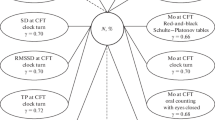Summary
A polygraphic study performed on 115 patients with late posttraumatic mental disturbances has shown marked alterations of the orienting reaction. The alterations, estimated by testing for the electrographic components of the orienting reflex elicited by a repetitive auditory stimulus and for their habituation, were expressed by changes in the intensity, resistance to habituation, and sequence of habituation of the somatic, autonomic, and EEG components. The character and severity of these alterations depend on the clinical aspects of the mental disturbance, the lesional aspect of the craniocerebral trauma, the site of the traumatic impact, and the features of the EEG tracings.
Similar content being viewed by others
References
Arseni, C., and Oprescu, I.:Traumatologia Craniocerebralâ. Bucharest: Ed. Medicalâ, 1972.
Bethlem, J.: Post-traumatic encephalopathy.Psychiat. Neurol. Neurochir., 71, 281–286, 1968.
Cairns, H.: Gunshot wounds of the head in 1940.Journal of the Royal Army Medical Corp, 86, 12–22, 1941.
Cushing, H.: A study of a series of wounds involving the brain and its enveloping structures.British Journal of Surgery, 5, 558–684, 1918.
Evans, J. P., and Scheiner, I. M.: Histologie studies of the brain following head trauma. IV. Late changes, atrophie sclerosis of the white matter.Journal of Neurosurgery, 1, 306–320, 1941.
Girard, P. F., Tommasi, M., and Trillet, M.: Les lésions anatomiques de l’encéphalopathie post-traumatique.Acta Neuropathologica (Berlin),2, 313–327, 1963.
Jellinger, K., Gerstenbrand, E., and Pateisky, K.: Die protrahierte form der post-traumatischen encephalopathien.Nervenarzt, 34, 145–159, 1963.
Meirowsky, A. M.: Penetrating cranio-cerebral trauma; observations in Korean war.Journal of the American Medical Association, 154, 666–669, 1954.
Penfield, W., and Erickson, T.:Epilepsy and Cerebral Localization. Springfield, Ill.: Charles C Thomas, 1941.
Rogozea, R., and Florea-Ciocoiu, V.: The orienting reflex in epilepsy. Electrographic data concerning the interparoxysmal peculiarities of the orienting reflex in epileptics.European Neurology, 9, 275–286, 1973.
Author information
Authors and Affiliations
Rights and permissions
About this article
Cite this article
Rogozea, R., Florea-Ciocoiu, V. & Kreindler, A. Alterations of the orienting reaction in patients with late posttraumatic mental disturbances. Pav. J. Biol. Sci. 16, 90–96 (1981). https://doi.org/10.1007/BF03001850
Issue Date:
DOI: https://doi.org/10.1007/BF03001850




